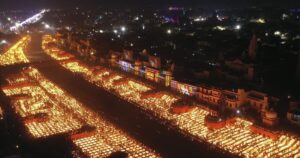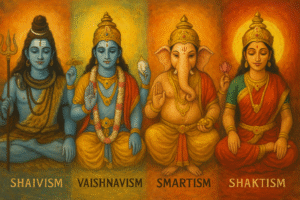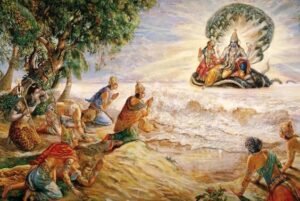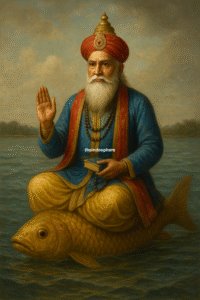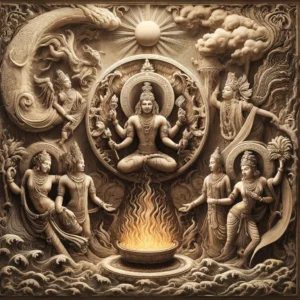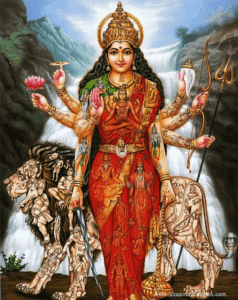
Chamunda Mata is a powerful and fierce aspect of Goddess Durga, embodying the destructive energy of the divine feminine, or Shakti. She is particularly revered for her role in the destruction of demons and her ability to eradicate evil, making her a symbol of both protection and the fierce power of the goddess. Chamunda Mata is a manifestation of Durga, specifically known for slaying the demons Chand and Mund, which is how she gets her name.
The Story of Chamunda Devi
The most famous story of Chamunda Mata is found in the Devi Mahatmya (also called Durga Saptashati), a sacred text describing the triumph of the goddess over various demons. This text tells the story of how Chamunda Devi was born from Goddess Durga during the epic battle against the demon kings Shumbh and Nishumbh.
After the demon generals Chand and Mund were sent to capture Durga, the goddess became enraged at their aggression. She took on the terrifying form of Kali or Chamunda, with dark skin, fierce eyes, and wild hair. In this form, she fought a fierce battle, quickly defeating Chand and Mund, beheading them, and offering their heads to Durga. This act symbolizes the destruction of evil and earned her the title Chamunda, the slayer of Chand and Mund.
Why Chamunda Mata is Revered
Chamunda Mata is deeply revered for her fierce protective nature. While other forms of Durga may be worshipped for their maternal or benevolent aspects, Chamunda represents the goddess’s power to destroy evil forces, protect the righteous, and eliminate fear and obstacles from the lives of her devotees.
Worshippers of Chamunda Mata often seek her blessings for:
- Protection from negative forces, both internal (like anger and fear) and external (evil or enemies).
- Strength and courage to face challenges, especially those that seem insurmountable.
- Liberation from evil and negativity, as Chamunda is seen as a force that purifies and eliminates harmful influences.
How and Where Chamunda Mata is Worshipped
Chamunda Mata is worshipped with great devotion, particularly in northern and western India. Devotees pray to her during special rituals that often include offerings of flowers, fruits, and red cloth (which symbolizes her fierce energy). Chamunda is especially honored during the festival of Navratri, a nine-night celebration of the goddess, during which each form of Durga is worshipped on different days.
Key Aspects of Worship:
- Prayers and Mantras: Devotees recite Chamunda Mantras to invoke her blessings. The most famous is the Chamunda Gayatri Mantra.
- Offerings: Flowers, incense, coconut, and red-colored clothes are offered to Chamunda, symbolizing her powerful energy.
- Rituals and Fasts: Some devotees fast in her honor and perform special pujas to invoke her blessings for protection and strength.
Chamunda Mata Temples
There are many temples dedicated to Chamunda Mata, especially in regions like Himachal Pradesh, Rajasthan, Madhya Pradesh, and Gujarat, where her worship is most prominent.
Famous Chamunda Devi Temples:
- Chamunda Devi Temple, Himachal Pradesh: Located near the town of Dharamshala, this temple is one of the most revered shrines for Chamunda Mata. Situated on the banks of the Baner River, it offers stunning views of the Dhauladhar mountain range. Thousands of pilgrims visit the temple every year, especially during Navratri.
- Chamunda Mataji Temple, Rajasthan: Located in Jodhpur, Rajasthan, this temple is one of the major places of worship for Chamunda devotees. Chamunda Mata is also considered the Isht Devi (personal goddess) of the royal family of Jodhpur.
- Chamundi Hill Temple, Karnataka: In the southern part of India, the Chamundi Temple in Mysore is another famous shrine where Chamunda Mata (also called Chamundeshwari here) is worshipped. The temple sits atop Chamundi Hill and is a major pilgrimage site, especially during the Dussehra festival.
- Chausath Yogini Temple, Madhya Pradesh: In this ancient temple near Bhedaghat, Chamunda Mata is worshipped along with other yoginis, as part of the 64 forms of the goddess. The temple is known for its unique circular structure and historical significance.
Festivals Dedicated to Chamunda Mata
- Navratri: During the nine-day festival of Navratri, the eighth day (Durga Ashtami) is often dedicated to Chamunda Mata. Devotees perform special prayers to invoke her blessings for strength, protection, and success.
- Dussehra: Chamunda is also celebrated during Dussehra, a festival that marks the triumph of good over evil, paralleling the goddess’s own victories over demons like Chand, Mund, and Raktabeej.
Are Chamunda and Kali the Same? Understanding the Fierce Forms of the Goddess
Chamunda and Kali are often considered closely related forms of the fierce Goddess Durga, both embodying the destructive power of the Divine Mother. While Chamunda is primarily known for slaying the demons Chand and Mund, Kali is famous for killing Raktabeej and other demons. Both represent the same protective, fearsome aspect of Shakti, though they are celebrated in slightly different stories and regions.
Chamunda Mata, the fierce aspect of Durga, represents the indomitable power of the divine feminine to destroy evil and protect the righteous. Her stories, temples, and the deep devotion surrounding her worship reflect her significance in Hindu culture as a powerful guardian deity. Whether through fierce battle or her compassionate protection, Chamunda Mata’s energy is revered as the ultimate force that can eradicate fear, remove obstacles, and bring about the triumph of good over evil.

